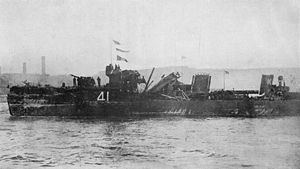Name HMS Spitfire Beam 27 ft (8.2 m) Launched 23 December 1912 Draft 3.2 m | Draught 10 ft 6 in (3.20 m) Length 82 m Builder Swan Hunter | |
 | ||
Fate Sold for scrapping on 9 May 1921 Propulsion Yarrow-type water-tube boilers, Parsons steam turbines | ||
HMS Spitfire was an Acasta-class destroyer of the Royal Navy which took part in the battle of Jutland in 1916.
Contents
Construction
She was launched on 23 December 1912 from the Wallsend yard of Swan, Hunter & Wigham Richardson and joined the Fourth Destroyer Flotilla.
Service during First World War
From the beginning of the First World War, Spitfire and her flotilla were attached to the Grand Fleet.
Battle of Jutland
Amongst the small engagements which happened during the night of 31 May–1 June 1916 during the Battle of Jutland was one between Spitfire and the German battleship Nassau. Spitfire evaded an attempt by Nassau to ram her, but the two ships nevertheless collided and Spitfire was seriously damaged, blast from Nassau's guns demolishing much of her upperworks, but she ripped off a 20 feet (6.1 m) section of the German ship's side plating. Both ships survived to return to port.
Assistance to the hospital ship Rhodesia
Spitfire helped in the rescue of survivors from the hospital/evacuation ship Rhodesia (formerly the Union Castle liner Galway Castle) which was torpedoed 160 miles off Fastnet by the German submarine U-82 on 12 September 1918.
Disposal
Spitfire was sold to Thos W Ward shipbreakers for scrapping on 9 May 1921.
